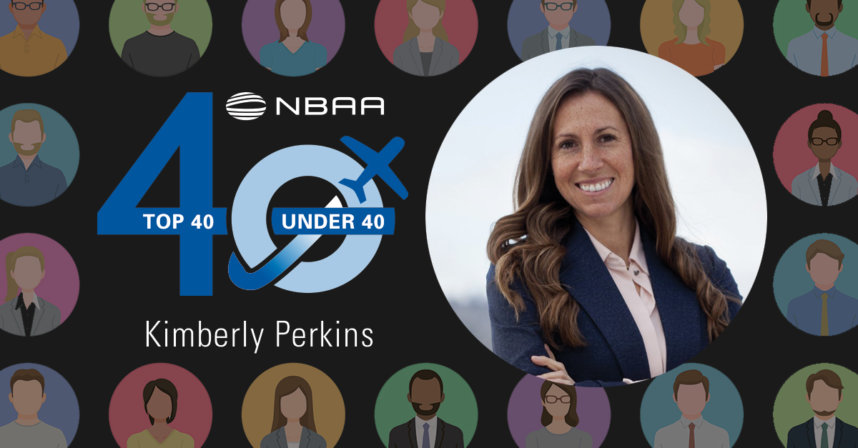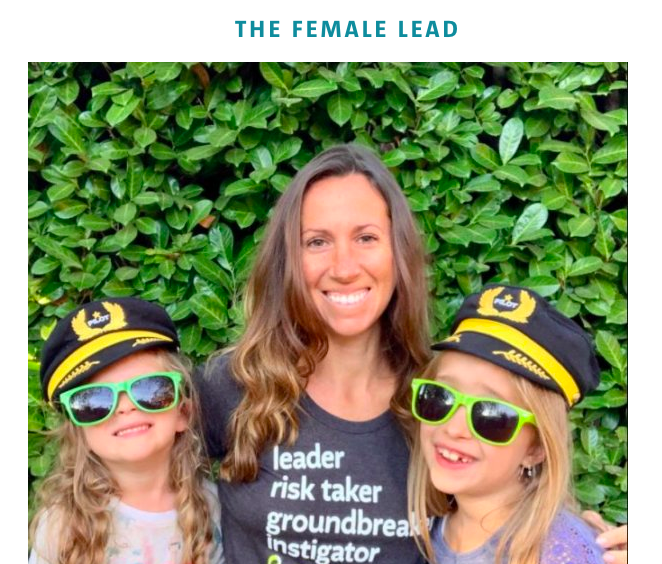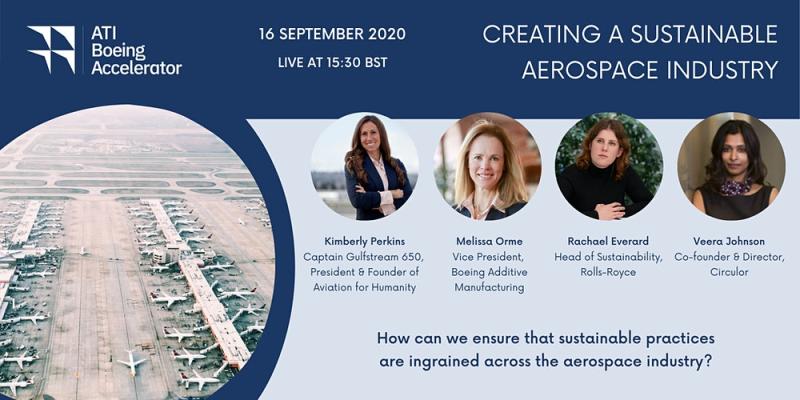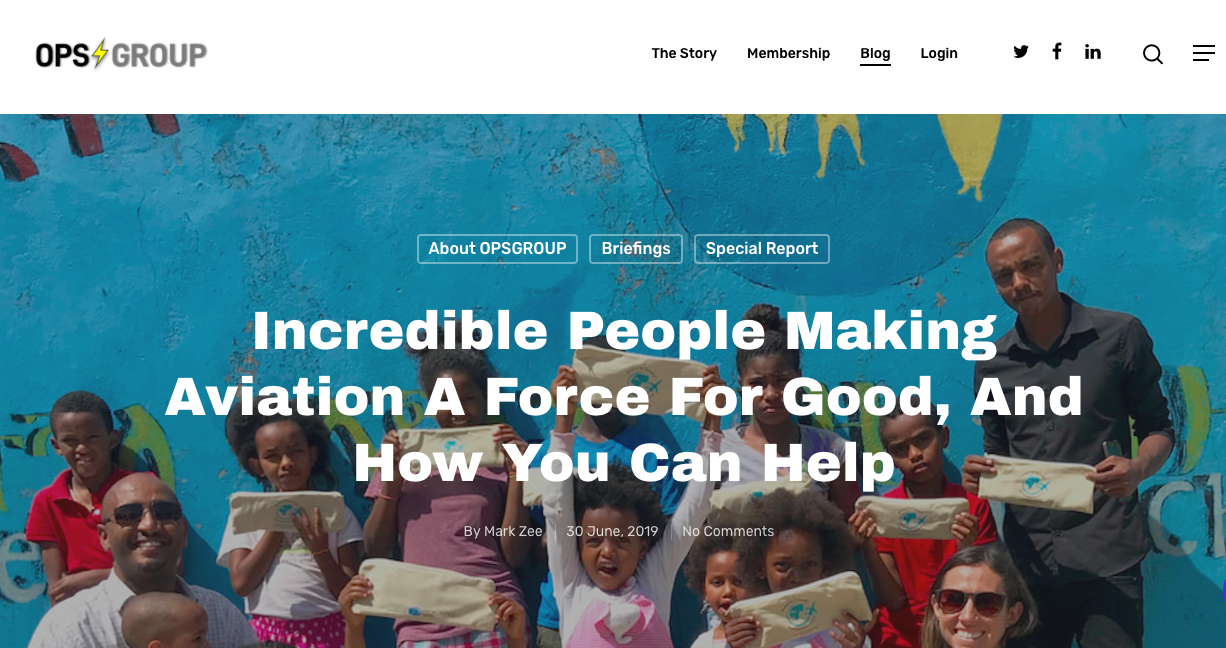|
Kimberly Perkins is, in no particular order: an international pilot, marathon runner, devoted mother, researcher, speaker, and published author. She’s also a charitable entrepreneur creating Aviation for Humanity, a non-profit engaging with the traveling public to bring school supplies to underfunded schools worldwide.
Perkins is a trailblazer within business aviation, where she’s a regular presence affirming the value of a more inclusive workforce. “Our current safety processes are important, but they break down without inclusion,” she says. “We’re entering a new wave of aviation safety that focuses on inclusivity because investing in human capital is our industry’s most precious resource.”
1 Comment
The Life of a Female Pilot: International Captain Kimberly Perkins Shares The Challenges She Faced as One of Few Women in The Industry, Pilot Life During Covid-19, and Aviation For Humanity “Female career pilots make up just 5% of all pilots in the United States. And, as Captain, we make up only 2%. Decades later, These numbers have barely budged.” Today’s woman dreamer, Kimberly Perkins, is an international captain and an outspoken advocate for bringing gender equality and diversity to the world of flying. With a childhood passion for science and a drive for adventure, Kimberly has flown on six continents and lived in three. A True Trailblazer! In this interview, Kimberly discusses the adversities and challenges she faces as one of the few female pilots, what life for a pilot looks like during Covid-19, her passion for driving diversity in the airline industry, and her advice to women everywhere. Enjoy her amazing and thought-provoking story below. 1) Tell us your story. What inspired you to become a pilot?
When I was in high school I used to spend a lot of time in the science lab. I loved science classes. I dreamed of doing a variety of science-type jobs but never aviation. While touring universities, I came across a college with a flight program. Daniel Webster College was set on an airport just 45 minutes north of Boston and had a fleet of aircraft, including gliders and aerobatic airplanes. While on a campus tour, I became interested in the flight program and got excited about the idea of flying. I inquired about the program to the Sophomore giving the tour. He was quick to compliment the program but followed up with “it’s very competitive; most people drop out; and you probably wouldn’t make it.” Without hesitation I thought, “that sounds perfect”. I enrolled in the program that fall, completed it three semesters early and went on to have a career at the airlines and within business aviation. Sometimes an adversary’s doubt is just an invitation to be more tenacious. 2) What is it like being a female pilot? Were there any challenges or adversities you faced along the way? I’ve been fortunate enough to pilot jet aircraft on six continents and live on three. Piloting has allowed me to see the world in an extraordinary way; and for that, I’m so very grateful. Seeing the uniqueness of different cultures yet the similarities in us all formed a deeper appreciation of humanity. I used my experiences overseas to create the non-profit Aviation for Humanity, which engages the traveling public to bring school supplies to underfunded schools, shelters, and orphanages around the world. “Female career pilots make up just 5% of all pilots in the United States. And, as Captain, we make up only 2%. ”While aviation has been great in so many ways, it can sometimes feel isolating, and this is one of the many challenges female pilots face. Female career pilots make up just 5% of all pilots in the United States. And, as Captain, we make up only 2%. After decades of recruiting, these numbers have barely budged. Traditional explanations, such as high training costs and rigorous schedules, have been named as probable causes, but these hurdles are non-gendered and disregard the unique challenges that women and minorities have to overcome. “Women make up 14% of student pilots but only 5% of career pilots, so we lose women somewhere along the career path. A survey of 100 career women pilots revealed that bias and discrimination show up as dissuading factors in both the recruitment and retention of women. ”Women face invisible barriers making a challenging career even more rigorous. While challenges affect people in different ways, there are five major barriers that I’ve experienced in my 18 years within aviation: the double bind, myth of the meritocracy, conformity for social capital, tokenism, and the ideal worker default. Women make up 14% of student pilots but only 5% of career pilots, so we lose women somewhere along the career path. A survey of 100 career women pilots revealed that bias and discrimination show up as dissuading factors in both the recruitment and retention of women. Overt discrimination and explicit bias are usually easy to recognize; but biases can show up in subtle ways creating invisible challenges that disproportionately affect women, caregivers, and minorities. In order to find solutions to these challenges, it’s important to label and define them: the double bind (femininity requires a softness but leaders require strength, so as women become more successful there becomes a there’s-just-something-I-don’t-like-about-her factor to overcome); the myth of the meritocracy (a false belief that everyone has an equal opportunity to success, which negates the advantages bestowed on the majority and masks the rampant gender stereotyping holding women back); conformity for social capital (the more a woman can blend in, the larger her network becomes); tokenism (having to prove your worth because people think you didn’t get your position on merit), and the ideal worker default (a structure that benefits those free from caregiving responsibilities, which don’t tend to be women). “I channeled this desire towards supporting women in aviation. I began researching, writing and speaking about gender parity and the invisible barriers that are creating challenges for women in the field.”These challenges are not unique to aviation, but they are persistent here. My goal is to make the flight deck door accessible to anyone with the dream of flying. I feel so fortunate to be in the position I am in, and I feel an overwhelming desire and sense of responsibility to give back to and help others access the industry that I love. For the last few years, I channeled this desire towards supporting women in aviation. I began researching, writing and speaking about gender parity and the invisible barriers that are creating challenges for women in the field. I love this work, and, admittedly, recently I began to feel stuck. While there is energy and encouragement from many allies, the discussions are sometimes met with resistance and hostility creating a strong “us vs. them” posture, which makes it very difficult to affect change. To this end, recently I co-founded Third Wave Aviation. At Third Wave, we are committed to reframing the emphasis from “difference” to “shared purpose” of ensuring an integrated approach to aviation safety that honors the individual while supporting the collective. We aim to include broader definitions of personal and physical safety and give professionals tools that will empower them to create safety for themselves, their colleagues, and the collective people and companies they serve. Everyone will benefit from a fresh approach that transcends blame, judgement and categorization, and promotes whole-system wellness. 3) Would you say you are a risk-taker? What is your advice to women who are afraid of taking risks and fellow risk-takers? I would definitely categorize myself as a calculated risk-taker. I love saying “yes” to new opportunities but before I do, I often spend a lot of time weighing out the pros and cons. I try not to waste too much time worrying about what others will think or whether I’ve veered from the traditional path. Early on in my career when I was an airline pilot, my airline furloughed staff because of the 2008 financial crisis. I took a risk and moved to Nigeria and flew around West Africa for a regional airline. Some thought that I was crazy to move half-way around the world for another airline job, but it was one of the best decisions that I made. It opened my eyes to rampant inequalities throughout much of the world, which laid the framework for creating Aviation for Humanity. In 2009, I took another risk and left the airline world completely for an opportunity in business aviation, this time in Kuala Lumpur, Malaysia. At the time, it seemed like a risk to leave the airline industry and step into business aviation, but it became a critical transition in my career. These international jobs ended up being an unexpected portal for many of my subsequent jobs back in the United States and a key factor in helping me climb the metaphorical success ladder within business aviation, right up to my current position as a Captain on a Gulfstream 650. “Men have always been the default in aviation. I’ve watched women hide their femininity to fit some arbitrary mold” My advice is this: don’t buy into the default. What I mean by that is just because things have always been done a certain way or something has always looked a certain way, doesn’t mean it needs to keep being that way. Men have always been the default in aviation. I’ve watched women hide their femininity to fit some arbitrary mold (the conformity for social capital barrier). When people do this, they give up a piece of themselves to fit in. Even worse, it means the perpetuation of this cycle forcing the next generation to deal with this barrier as well. Let’s break that cycle. If we don’t question and challenge the default of our own industries, who will? We can challenge this default by succeeding in our field while remaining our 100% authentic selves. So, don’t feel like you have to fit a certain mold. Growth and progress comes from challenging the status-quo. So, don’t buy into the default. 4) You are an international Captain on a Gulfstream 650 aircraft, and have piloted jet aircraft on six continents and lived on three. What place is your dream to fly to next? I’ve been so fortunate to have traveled around the world – several times. I’ve loved every country so far. Two years ago I trekked through the Himalayas in Nepal and fell in love with that region of the world. Because I’m an avid trekker and the mountains always seem to be calling, I’d love to fly to Bhutan. 6) How has air travel and the life of a pilot changed with Covid? COVID-19 has certainly affected the aviation industry – in a significant way. It has required all of us to take a pause and reevaluate what’s important. The aviation industry lacks diversity. There are an abundance of justifications for the homogeneity of the industry – but rarely is nepotism, misogyny or negative gender stereotypes discussed as probable explanations, which is why we haven’t really moved the needle on making the industry more diverse. Around the world and throughout many industries, COVID has magnified inequities. It has shown that women are disproportionately disadvantaged bearing an unequal burden of childcare and work. And, it has magnified the inequities across social and economic systems nationally and around the world. “It may take longer to bounce back, but it will. And, when it does, I hope that we’ve built a better structure to end inequities within aviation. ”COVID has put a spotlight on humanity. The aviation industry will bounce back, just like after 9/11 and the 2008 financial crisis. It may take longer to bounce back, but it will. And, when it does, I hope that we’ve built a better structure to end inequities within aviation. Let’s not go back to the status quo, which wasn’t working for everyone. Let’s build a more inclusive industry through integrated safety. Picture a pilot. Is that pilot a man? If so, you’re probably right. Men make up 95% of all the pilots in America. Five decades of recruiting efforts have raised the percentage of female pilots from 3.5% in the 1960s to 5% today.
I’m one of them. Organizations have been formed to recruit, train and mentor women in this field, but despite these efforts the numbers remain dismal. The past five decades shows us that the industry trajectory for gender parity is centuries away. If moralistic reasons weren’t enough to jump aboard the gender-parity train, perhaps fiscal motivations can compel you. Despite the future-is-female campaigns and Rosie the Riveter posters, women have not gravitated toward piloting at any substantial rate. As an industry, women make up nearly 30% of non-pilot jobs. But, a woman in aviation is twice as likely to be an aerospace engineer than a pilot and five times as likely to be an air traffic controller. Female pilots make up 12% of the student-pilot population. As they progress in their career, that percentage dips to 6% at an intermediate level (commercial-pilot license) and dwindles to just 4% at the highest rung of the career ladder. Even when the recruitment does attract women through the flight-deck door, something within the industry turns them away. As a Seattle-based female captain with almost two decades of flying experience, I have watched women leave the industry at varying stages of their career, but almost always for the same reasons: the industry has poor quality-of-life policies and is not family-friendly. While family care should not be a gendered-role, women, worldwide, are responsible for 75 % of the unpaid labour (care and domestic work), which helps explains why women are missing from the flight deck. The aviation-industry structure disproportionately favours men, not maliciously, but because it was built by men for men years ago. That status quo worked for decades, but it is failing us now. The pilot shortage is real. Airlines are parking planes and cancelling flights due to a lack of crew. Boeing’s CEO estimates that the pilot shortage is one of the industry’s biggest challenges and predicts a need of 800,000 new pilots within the next two decades. Aside from the moral obligations to advocate for gender parity, we now have financial reasons to recruit more women. But recruiting alone is not enough. It is time for the aviation industry to restructure through an inclusive lens. Paid family leave, child-care allowances, tuition reimbursement and schedule-predictability policies should become the industry norm. Such initiatives will retain both women and men while also recruiting more aviators into the pilot pipeline. The industry already has a lot to offer, such as unique schedules, salaries above $100,000 after a few years, and, of course, the opportunity to see the world with a pretty amazing office view. If the industry would adopt more quality-of-life initiatives as standard practice, it would not have to hard-sell new recruits. Simple solutions and revolutionary restructuring are obtainable, but it will take all of us to challenge the status quo. Modernity has transformed not only the airplanes themselves, but the meaning of what defines a “good” pilot and the skills necessary for the job. Technological advancements have yielded nearly self-sufficient flying computers, yet they lack the human social skills necessary to function in a collaborative, crew environment. The ability to rationalize, empathize and evaluate qualitatively are the “soft skills” necessary to work in a fast-paced, multi-crew environment. Airlines know the importance of these soft skills, which is why they include them in their hiring criteria along with piloting experience and education. One’s emotional intelligence is no longer a trait only for managers, but a metric used to determine if a potential new-hire is a good fit with the company’s culture. The skills needed to aviate have been weighted by a modern scale. So, what does this mean for women? It means that women are missing from the flight deck because of socially constructed barriers. The good news: We can fix this. We’ve seen technological advancements transform aircraft and improve the very definition of what makes for a “good” pilot. Now, it is the industry’s responsibility to transform policy so we can recruit and retain more pilots and reverse the pilot shortage. The overhaul of the industry must include re-evaluating the structure through a more inclusive lens with family-friendly and quality-of-life initiatives. The best of the industry is still ahead of us, but we can’t get there without all becoming advocates for gender parity. Kimberly Perkins: https://www.kimberly-perkins.com/ Kimberly’s EDI Think Tank space: https://www.kimberly-perkins.com/editt.html Third Wave Aviation email: [email protected] Aviation for Humanity: https://www.aviationforhumanity.org/ Connect on Linked In Kimberly Perkins is among the 2% of pilots in the United States – a female captain. She’s a Captain on a Gulfstream 650 based in Seattle, WA and has piloted jets on six continents. After living in Nigeria for two years, she started a non-profit called Aviation for Humanity. They use the traveling public to bring school supplies to children in underfunded schools, shelters and orphanages around the world. Hear more about Kimberly’s nonprofit as well as her thoughts on gender parity and equity initiatives in aviation.
 Michelle King, Director of Inclusion at Netflix, interviews Kimberly Perkins on the invisible barriers that are keeping women from the flight deck. Listen HERE. From The Fix Podcast: "In the United States, women make up 47% of the total workforce. But professional female pilots constitute five percent of the piloting workforce, a statistic that has remained unmoved in four decades. Compared to other STEM fields and “traditionally” male-dominated industries, aviation has one of the lowest percentages of women. There are mentors, scholarships, conferences, magazines and organizations that all have a goal to increase the abysmal five percent statistic. When experts are questioned on this topic, often the same old explanation is given: “It’s a pipeline problem.” On today's episode, Kimberly Perkins, an International Captain and Safety Officer on Gulfstream 650 aircraft based in Seattle, Washington and humanitarian activist through Aviation for Humanity will reveal what the systemic barriers are to women’s advancement in aviation and why the industry has to change." Airlines offer workload variations that crewmembers can bid on. If someone wanted to work more, there are options to bid a schedule with a high utilization. The same applies if someone wanted a reduced number of days away. Business aviation could adopt a similar structure and pay could reflect utilization so its equitable. I know plenty of working caregivers that would value such an option."
March 9th, 2020
"Anecdotal evidence suggests many women who leave aviation believe that the industry is not family-friendly, explained Kimberly Perkins, an international captain and safety officer, founder of Aviation for Humanity and a gender equality activist. “Much like soft skills and emotional intelligence are the welcome wave of the future for measuring talent, the industry must adopt another cultural shift, this time with a focus on family-friendly initiatives,” asserts Perkins. “Having a work/life balance isn’t a women’s issue – it’s everyone’s issue.” “We need to stop rewarding the 70-hour work week and instead get more creative on how to work just as effectively but more efficiently,” continued Perkins, who sees teleworking, flex hours and variations in utilization as quality-of-life initiatives." Read the full article ONLINE HERE Kimberly Perkins on why diversity and inclusivity matters to business aviation. Recorded in Las Vegas, NV at NBAA's Business Aviation Convention & Exhibition October, 2019.
|
|||||||||||
Proudly powered by Weebly













 RSS Feed
RSS Feed